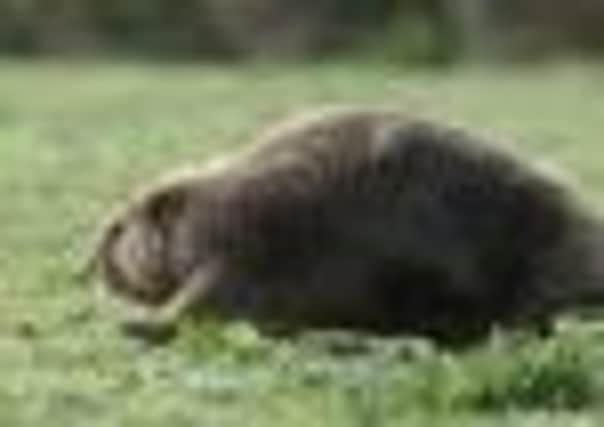Over 100 rogue beavers running wild in Tayside rivers


• Trapping project by Scottish Natural Heritage two years caught one beaver, that later died in Edinburgh Zoo
• Around 146 beavers currently inhabiting over 70 miles of rivers and tributaries
Advertisement
Hide AdAdvertisement
Hide Ad• Tayside Beaver Study Group keen to advise on non-lethal methods of dealing with beavers
Earlier this year the beavers living wild in the river system were granted a three-year reprieve from the Scottish Government, despite claims that the illegally released animals had caused widespread damage by felling trees, damming rivers and flooding fields.
The Government announced in March that the estimated 100 strong population would be allowed to remain in the wild until at least the end of a licensed trial reintroduction of beavers in Knapdale Forest, Argyll, in 2015.
A trapping project by SNH two years ago resulted in just one Tay beaver being caught. The animal died in Edinburgh Zoo.
But a new report by SNH has now revealed that “approximately 146 beavers” are presently living in the wild in rivers in Tayside with beaver groups occupying almost 70 miles of rivers and tributaries in the Tay
catchment.
An SNH spokesman said: “Surveys from May and July 2012, along with long-term observations, found that there are about 40 groups of beavers and seven dams in the Tay catchment. The beavers were found in the Tayside rivers and lochs stretching from Kinloch Rannoch, Kenmore and beyond Crieff in the west, to Forfar, Perth and Bridge of Earn in the East.”
He continued: “The researchers also spoke to farmers, fishermen and ghillies in the area. In response to their concerns about dam building, the report recommends measures such as installing devices to control water flow at problem beaver dams, protecting large and valuable trees next to rivers, and protecting lodges from being washed away to keep beaver construction activities to a minimum.”
David Bale, chairman of the Tayside Beaver Study Group, said: “This report is an important starting point for the Tayside Beaver Study Group. For the first time, we have a clear picture of how many beavers there are and how far they have spread. As the beavers are in an area with both farming and fishing, this is a good chance to see how beavers may affect land use.
Advertisement
Hide AdAdvertisement
Hide Ad“We encourage land managers to contact the Tayside Beaver Study Group if they have any issues with the beavers on their land. The group is keen to advise on non-lethal ways of managing problems arising from dams and burrowing in banks, as well as helping protect valuable trees.”
Ian Mackintiosh, speaking on behalf of the National Farmers’ Union Scotland, said: “NFUS welcomes this initial report with its indications of the numbers and spread over Tayside. The next two years must be used to provide the study group with evidence as to the lifestyle and habits of the beavers and their relationship to other land uses in the area. It’s also important to gather as much detail on the health status of the animals to ascertain if they are harbouring any diseases which might be difficult to control. We must be able to present the Minister with a report based on fact, assisting him in his decision to reintroduce or not. Farmers live in harmony with many species, but if it emerges there are conflicting issues, we must be able to mitigate timeously and without undue bureaucratic burdens.”
The report states: “We estimate that there are 38 to 39 groups of beavers present in the Tay catchment, equating to approximately 146 individual beavers. The River Earn, River Isla and Dean Water displayed the greatest density of beaver signs (and beaver groups), whereas the River Tay had the lowest density. We estimate that beaver groups occupy a total linear length of 112 kilometres of river and associated tributaries in the Tay catchment.
“Only three beaver groups had built dams. In these groups, seven dams were currently maintained. The dam-building activities of two of these groups were leading to localised issues, necessitating frequent dam-removal by the landowners. There were few signs of beaver foraging on crops. Problems with felled trees in rivers may be reduced over time. “
It continues: “We recommend trialling mitigation methods to allow people and beavers to coexist, including installing flow-control devices at problem beaver dams,i) protecting large or valuable trees next to rivers where issues may arise from felling, protecting lodges from being washed away to minimise beaver construction activity and maintaining and establishing riparian buffers which could benefit beavers and other wildlife and reduce conflict with human land-use.”
The European beaver, Castor fiber, was hunted to extinction in Scotland 400 years ago. The beavers in Tayside have been in the area since at least 2006, and originate either from escapes or deliberate releases from private collections.
In May 2008, the Scottish Government gave permission to the Royal Zoological Society of Scotland and the Scottish Wildlife Trust for a scientifically monitored, trial reintroduction of European beavers to Knapdale Forest .
An SNH spokesman explained: “Until 2015, the Minister has asked the Tayside Beaver Study Group to monitor and study the Tayside population. The decision on whether to reintroduce beavers to Scotland will be taken by the Minister for Environment and Climate Change, Paul Wheelhouse, based on the information gathered from the Knapdale trial, as well as on various studies undertaken by the Tayside Beaver Study Group.”